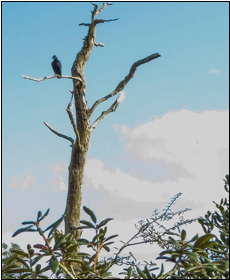by Sam Peters
 There is some debate about what constitutes a Snag, Is it a dead tree? Is it on the ground? Is it in the water? Is it a loose thread? The Urban Dictionary defines snags as a “sensitive new age guy.” So, there are many definitions … For our purposes, a Snag is a standing dead or dying tree.
There is some debate about what constitutes a Snag, Is it a dead tree? Is it on the ground? Is it in the water? Is it a loose thread? The Urban Dictionary defines snags as a “sensitive new age guy.” So, there are many definitions … For our purposes, a Snag is a standing dead or dying tree.
A Downed Tree is a log lying on or near a forest floor; however, a downed tree in a body of water is called a snag in certain areas of the South and Midwest. In Alaskan rivers it can be called a preacher. Other areas it is called a sawyer. Both sawyer and preacher derive from the tree or log rising and falling and bowing in a current of a river.
To some people, Snags are ugly and should be removed from a forest. After all, they are not classic, formal beauty; they’re dead. However, trees are the gift that keeps on giving. As they grow, they provide habitat and shelter for many different species; when they die, they still provide shelter and habitat, but now for different animals. Depending on the species of tree, it can last for as long as 70 years. They start out as Hard Snags, which means that they still have the bark and their cambium layer; as they lose their bark and decay further, they become Soft Snags. This is when the most animals begin to move in.
Some of the birds which use Snags are woodpeckers, wrens, barred owl, vultures and hawks. Also many insects, reptiles and amphibians call a dead tree home.
As the tree ages, different animals make use of it. For instance, woodpeckers will make use of an area of a snag and when the woodpeckers move on, other birds will enlarge the holes and move in. As they move on, more birds or other animals will make use of the cavity. This can go on until the cavity becomes large enough to house a squirrel, or a raccoon nest.
Some fungi, moss, and lichen live their entire lives on dead trees. Bacteria live in decaying wood, creating fertilizer which will mix with the soil when the tree falls. Shelf mushrooms make use of Snags and Downed Trees. Snags provide food and habitat for almost 1/3 of our wildlife. Over forty different types of birds use Snags at one time or another.
Snags should be protected and left standing for reasons of habitat and forest health. They are used for foraging, nesting, perching, hunting and roosting.
We need Snags to be maintained in a variety of sizes, shapes and ages. A group of larger Snags is more valuable as it provides habitat for a greater variety of species. Small clumps of snags will provide nesting and foraging sites. Snags should exist in various stages of decay, as they support different plants and animals at different stages of their existence. So, different stages for diverse species and different sizes and shapes for the same reason.
A single large Snag is rarely used by more than one pair of the same species.
Forest management now includes Snags. This would include not cutting down dead trees and culling trees in a crowded area, but leaving them standing and creating new Snags. Fire may also be used as fire can both create new Snags and destroy old ones.
What can we do? Depending on where we live, we can maintain Snags and/or create new ones. Please don’t use fire in your neighborhood. However, if a tree dies, leave it alone if it is not a danger to anything or cut it to a size where it will not hurt anything if it falls. You may also kill an unwanted tree yet leave it standing. Some of the ways to kill it would be to gird the tree, top and trim it and of course poison always works. Girding does weaken the tree and if done will rot the tree from the outside in. This will cause the tree to rot and fall much more quickly than when it dies and rots from the inside out, which is the natural way.
The Fakahatchee has many Snags in various states of decay. They occur naturally and are of great service to the forest community. If you look closely, you can see that the Snag is occupied by many animals and if you look twice you may even come to believe that they are beautiful in their own natural way.
Sam Peters is an FOF member from Miami Beach.
